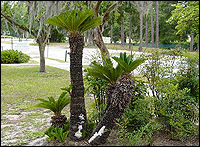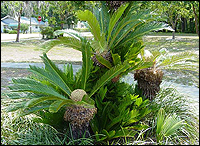|
Locations for studies were carefully chosen to provide for high-profile testing and results that were observed by numerous individuals. The first study, and the largest, was conducted at Stetson University, DeLand, FL. Stetson was very amenable to conducting studies at the institution due to their inability to keep the insect under control and the demise of the plants was inevitable. The process of selecting Cycads to treat with the pesticide solution containing “Pesticide Spray Additive” took into consideration the age of the plants, which was important due to the greater resilience in older plants and their ability to recover from such trauma as the CAS is capable of inflicting on the plants. The sagos treated in this first study were estimated to be 50 to 150 years of age. David Rigsby, the Director of Grounds Maintenance at Stetson, was most generous in allowing us to perform our studies on four stands of King Sagos at different locations on campus. Bill Gilbert, the resident pest control technician at Stetson, provided assistance in the spraying, pruning, and examination of the plants during the 6-month study. We are most grateful to them and the University for their continued assistance as we carefully watch the plants return to a normal growth pattern (See News Article #1).
The locations of each of the stands of cycads were as follows:
- Dupont Ball library located on the main campus near Elizabeth Hall
- Davis Hall of the business school located on Minnesota Avenue, west of the
main campus.
- The Wilson Athletic Center located near the Edmonds Center Gymnasium
- The Physical Plant located on East Minnesota Avenue where the largest stands of plants were located and were estimated to be 100-150 years old.
|
 |
The Second Study:
The second study was performed at Sanford Middle School, and we thank the Principal of the Middle School, Mark Russi, for allowing us save two sago palms that were estimated to be 30 to 50 years old. Mr. Russi told me that he had some sago palms of his own that died during this current blight of CAS and was very interested in having the Cycads at the school treated to prevent the insect from killing these large ornamental plants which adorned the entrance to the Middle School. (See Letter of Testimonial #1)
The Third Study:
The third study was conducted at Thelma Hassenplug’s home in Deltona, Florida. Ms. Hassenplug has eight King Sagos estimated to be 10-15 years old that were highly infested with the CAS and was prepared to remove them due to their unsightly appearance. I was fortunate to be able to convince her to allow me to treat them for 3 weeks and then decide if she still wanted them removed. After one month, I received a Letter of Testimonial describing how thrilled she was that we were able to save her beloved sago palms (See Letter of Testimonial #2).
The fourth study was conducted at Wanda S. Currie’s home in Geneva, Florida. Ms. Currie had several very large King Sago Palms estimated to be in excess of 50 years old. In addition, she had some younger King Sagos that were under 10 years of age. She also has some Queen Sagos which were highly infested and offered a new dimension to the study. These plants were in excess of 25 years old and had practically succumbed to the Asian Scale. They were exhibiting fronds that were deformed and yellowed from the infestation and without treatment, they would certainly have perished. After only three applications, I received a letter from her thanking us for saving her King and Queen Sago Palms. (See Letter of Testimonial #2)
The Fourth Study:
Was conducted at Wanda S. Currie’s home in Geneva, Florida. Ms. Currie had several very large King Sago Palms estimated to be in excess of 50 years old. In addition, she had some younger King Sagos that were under 10 years of age. She also has some Queen Sagos which were highly infested and offered a new dimension to the study. These plants were in excess of 25 years old and had practically succumbed to the Asian Scale. They were exhibiting fronds that were deformed and yellowed from the infestation and without treatment, they would certainly have perished. After only three applications, I received a letter from her thanking us for saving her King and Queen Sago Palms. (See Letter of Testimonial #3)
 |
The Fifth Study:
The fifth study was conducted at Bill Watford’s home in DeLand, Florida. He has some very old Sago Palms that were highly infested. He was very anxious to try the treatment and wanted to save his plants but was skeptical of the ability of the application to achieve results. After not hearing from him or his wife in 3 months, I became curious as to the effectiveness of the composition and I called his wife. I was elated to hear that she was thrilled with the results of the application. One of her most prized plants had made a complete turn around and was on its way to recovery. (See Letter of Testimonial #4) |
The Sixth Study:
Was conducted at Tim Van Dyke’s home in Orlando, Florida. Mr. Van Dyke is an attorney who put together the patent and the trademark for our product. His plants were less than ten years old but were highly infested and would surely have perished in the summer months if he had not requested that we treat them with our pesticide composition. This was one of the first situations in which the plants were treated only once. I found these results to be very impressive and within a month we received a letter from him thanking us for our efforts. (See Letter of Testimonial #5)
The Seventh Study:
The seventh study was conducted at Tim Fiedler’s home on a single stand of Sago Palms that had become highly infested with the Cycad Asian Scale. I provided Tim a pre-mixed sprayer of the solution. It was composed of Malathion-Oil, Funginex, and The Water Shed Laboratories, Inc. "Pesticide Spray Additive." Mr. Fiedler applied the solution only once and the results were remarkable. A practically dead King Sago is now on its way to a complete recovery. (See Letter of Testimonial #6)
The Eighth Study:
The eighth study was conducted at Kaiser Pontiac Buick GMC Truck located in DeLand, Florida. We provided Mr. Kaiser with a pre-mixed solution of Malathion-Oil containing The Water Shed Laboratories, Inc. “Pesticide Spray Additive.” The solution was applied as directed and the plants at the dealership are currently returning to a normal growth pattern after only one application. (See Letter of Testimonial #7)
The Ninth Study:
The ninth study was conducted at Sherrye Tolbert’s house on South Spring Garden Avenue in DeLand, Florida. Mrs. Tolbert had numerous Queen Sago Palms that were highly infested with the CAS and had lost 50% of them before we applied the standard solution of Malathion-Oil with the WSL’s “Pesticide Spray Additive.” Fortunately, we were able to treat the Cycads before their demise and the remaining plants are now producing healthy lush green fronds.
The Tenth Study:
The tenth study was conducted at Harland Paul’s Law Office in DeLand, Florida. This large King Sago estimated to be 30-50 years old is located on East New York Avenue, DeLand, Florida and had been infested with the CAS for a considerable amount of time. The infestation was not considered severe at the time and only one application of the standard Malathion-Oil with the WSL’s “Pesticide Spray Additive” was required. This plant returned to a normal growth pattern within one month’s time. (See Letter of Testimonial #8) |
 |
|

